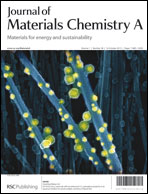Structural phase transformation and Fe valence evolution in FeOxF2−x/C nanocomposite electrodes during lithiation and de-lithiation processes
Abstract
In this study, the structural changes of FeOxF2−x/C during the first discharge and recharge cycles were studied by ex situ electron microscopy techniques including annular dark field scanning transmission electron microscopy (DF-STEM) imaging, selected area electron diffraction (SAED) and electron energy loss spectroscopy (EELS) as well as by in situ X-ray absorption spectroscopy (XAS). The evolution of the valence state of Fe was determined by combined EELS using the Fe-L edge and XAS using the Fe-K edge. The results of this investigation show that the conversion reaction path during 1st lithiation is very different from the re-conversion path during 1st delithiation. During lithiation, intercalation is first observed followed by conversion into a lithiated rocksalt (Li–Fe–O–F) structure, and metallic Fe and LiF phases. During delithiation, the rocksalt phase does not disappear, but co-exists with an amorphous (rutile type) phase formed initially by the reaction of LiF and Fe. However, a de-intercalation stage is still observed at the end of reconversion similar to a single phase process despite the coexistence of these two (rocksalt and amorphous) phases.


 Please wait while we load your content...
Please wait while we load your content...